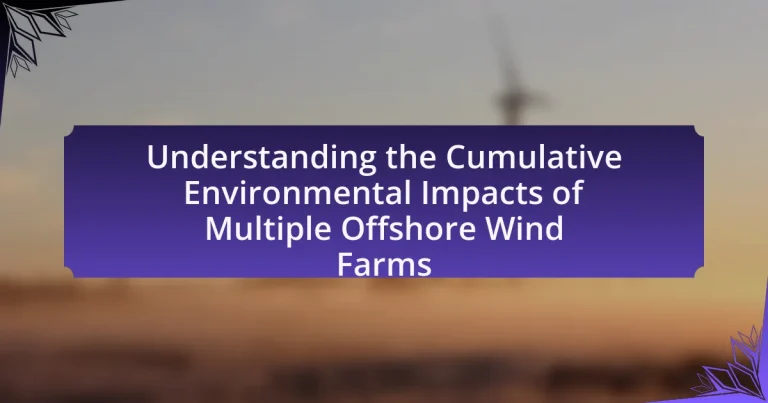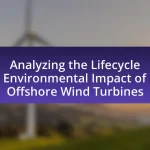The article focuses on the cumulative environmental impacts of multiple offshore wind farms, examining how their construction and operation affect marine ecosystems, biodiversity, and local wildlife. Key issues discussed include habitat alteration, changes in species distribution, and the socio-economic implications for local communities reliant on fishing and tourism. The article emphasizes the importance of understanding these cumulative effects to inform policy and regulation, highlighting methodologies for assessment and best practices for future developments to mitigate negative impacts. Additionally, it addresses the long-term consequences of ignoring cumulative impacts, particularly for vulnerable species and local economies.
What are the Cumulative Environmental Impacts of Multiple Offshore Wind Farms?
The cumulative environmental impacts of multiple offshore wind farms include alterations to marine ecosystems, changes in local biodiversity, and potential effects on fish populations and migratory bird patterns. These impacts arise from the construction and operation of wind farms, which can lead to habitat loss, noise pollution, and changes in water quality. Studies indicate that the presence of multiple wind farms can exacerbate these effects, as overlapping areas of influence may compound stress on marine life. For instance, research published in the journal “Environmental Impact Assessment Review” highlights that cumulative impacts can lead to significant shifts in species distribution and abundance, particularly for sensitive species.
How do offshore wind farms contribute to environmental changes?
Offshore wind farms contribute to environmental changes primarily by altering marine ecosystems and influencing local biodiversity. The construction and operation of these farms can lead to habitat modification, as the installation of turbines and associated infrastructure can disrupt seabed habitats and affect species distribution. Research indicates that the presence of wind farms can create artificial reefs, which may enhance local biodiversity by providing new habitats for marine life. Additionally, the reduction of greenhouse gas emissions from wind energy generation contributes positively to climate change mitigation, impacting global environmental conditions. Studies have shown that offshore wind farms can reduce reliance on fossil fuels, thereby decreasing air pollution and its associated environmental impacts.
What specific environmental factors are affected by offshore wind farms?
Offshore wind farms specifically affect marine ecosystems, bird populations, and local water quality. Marine ecosystems can be disrupted due to habitat alteration from the installation of turbines and associated infrastructure, which can lead to changes in species composition and abundance. Bird populations are impacted through collision risks with turbine blades and habitat displacement, particularly for migratory species. Local water quality may be affected by sediment disturbance during construction and potential changes in nutrient dynamics due to altered water flow patterns. These factors are critical in assessing the cumulative environmental impacts of multiple offshore wind farms, as evidenced by studies indicating significant interactions between these elements and the operational phases of wind energy projects.
How do these impacts vary with the number of wind farms?
The impacts of multiple offshore wind farms generally increase with the number of installations. As the number of wind farms rises, cumulative effects on marine ecosystems, local wildlife, and sediment dynamics become more pronounced. For instance, studies indicate that increased wind farm density can lead to greater habitat alteration and increased noise levels, which can disrupt marine life, particularly species sensitive to sound. Additionally, research shows that the collective presence of multiple wind farms can amplify changes in local hydrodynamics and sediment transport, potentially affecting coastal erosion and sedimentation patterns.
Why is it important to understand cumulative impacts?
Understanding cumulative impacts is crucial because it allows for a comprehensive assessment of how multiple offshore wind farms collectively affect the environment. This understanding helps identify potential risks to marine ecosystems, biodiversity, and local communities that may not be evident when evaluating each project in isolation. Research indicates that cumulative impacts can lead to significant changes in habitat quality and species populations, necessitating integrated management strategies to mitigate adverse effects. For instance, a study published in the journal “Environmental Impact Assessment Review” highlights that failing to consider cumulative impacts can result in underestimating the overall environmental footprint of renewable energy projects.
What are the potential long-term consequences of ignoring cumulative impacts?
Ignoring cumulative impacts can lead to significant long-term environmental degradation, including loss of biodiversity and ecosystem services. When multiple offshore wind farms are developed without considering their combined effects, habitats may be irreversibly altered, leading to declines in fish populations and other marine life. Research indicates that cumulative impacts can exacerbate stressors such as climate change and pollution, resulting in diminished resilience of marine ecosystems. For instance, studies have shown that the cumulative effects of multiple stressors can lead to a 50% reduction in species diversity in affected areas. This loss not only affects ecological balance but also undermines the economic benefits derived from healthy marine environments, such as fisheries and tourism.
How can cumulative impacts influence policy and regulation?
Cumulative impacts can significantly influence policy and regulation by necessitating a comprehensive assessment of environmental effects from multiple projects. Policymakers must consider the aggregate effects of offshore wind farms on ecosystems, which can lead to stricter regulatory frameworks aimed at mitigating negative outcomes. For instance, the National Environmental Policy Act (NEPA) in the United States requires federal agencies to evaluate cumulative impacts in their environmental assessments, ensuring that the combined effects of multiple projects are taken into account. This approach can result in enhanced guidelines for project siting, operational practices, and monitoring requirements, ultimately shaping more sustainable development strategies in the offshore wind sector.
What methodologies are used to assess cumulative environmental impacts?
Cumulative environmental impacts are assessed using methodologies such as cumulative impact assessment (CIA), spatial analysis, and modeling techniques. CIA evaluates the combined effects of multiple projects or activities on the environment, considering both direct and indirect impacts over time. Spatial analysis employs geographic information systems (GIS) to visualize and analyze the spatial relationships and potential cumulative effects of various environmental stressors. Modeling techniques, including ecological modeling and simulation, predict the potential impacts of multiple offshore wind farms on ecosystems by integrating various environmental data and scenarios. These methodologies are essential for understanding the broader implications of offshore wind farm developments on marine and coastal environments.
How is data collected for assessing these impacts?
Data for assessing the cumulative environmental impacts of multiple offshore wind farms is collected through a combination of remote sensing, field surveys, and modeling techniques. Remote sensing involves the use of satellite imagery and aerial surveys to gather information on environmental conditions and changes over time. Field surveys provide direct observations and measurements of ecological parameters, such as species populations and habitat conditions, while modeling techniques simulate potential impacts based on collected data and environmental variables. This multi-faceted approach ensures comprehensive data collection, enabling accurate assessments of the cumulative effects of offshore wind farms on marine ecosystems.
What types of data are most relevant for cumulative impact assessments?
Cumulative impact assessments primarily rely on environmental, social, and economic data. Environmental data includes information on biodiversity, habitat conditions, and ecosystem services, which are crucial for understanding the ecological effects of multiple offshore wind farms. Social data encompasses community demographics, land use patterns, and public health indicators, providing insights into how local populations may be affected. Economic data involves assessments of local economies, job creation, and potential impacts on industries such as fishing and tourism. These data types collectively enable a comprehensive evaluation of the cumulative effects of offshore wind farms on the environment and communities.
How do researchers ensure data accuracy and reliability?
Researchers ensure data accuracy and reliability by implementing rigorous methodologies, including standardized data collection protocols and validation techniques. They utilize tools such as calibration of instruments, replication of studies, and peer review processes to confirm findings. For instance, in environmental studies, researchers often cross-verify data with multiple sources, such as satellite imagery and field measurements, to enhance reliability. Additionally, statistical analyses are employed to assess data consistency and identify potential errors, ensuring that the conclusions drawn about the cumulative environmental impacts of multiple offshore wind farms are based on robust and trustworthy data.
What analytical frameworks are commonly employed?
Commonly employed analytical frameworks for understanding the cumulative environmental impacts of multiple offshore wind farms include the Ecosystem-Based Management (EBM) framework, the Integrated Assessment Models (IAM), and the Environmental Impact Assessment (EIA) framework. EBM focuses on the holistic management of ecosystems, considering the interactions between human activities and environmental health. IAM combines various disciplines to assess the environmental, economic, and social impacts of energy systems, providing a comprehensive view of potential outcomes. EIA is a systematic process that evaluates the potential environmental effects of proposed projects, ensuring that decision-makers consider environmental factors before proceeding. These frameworks are validated by their widespread application in environmental studies and regulatory processes, demonstrating their effectiveness in assessing complex environmental interactions.
How do these frameworks help in understanding cumulative impacts?
These frameworks facilitate the understanding of cumulative impacts by providing structured methodologies for assessing the combined effects of multiple offshore wind farms on the environment. They enable stakeholders to systematically evaluate how individual projects interact and contribute to broader ecological changes, thereby identifying potential risks and synergies. For instance, frameworks like the Strategic Environmental Assessment (SEA) and Environmental Impact Assessment (EIA) incorporate cumulative impact assessments, which have been shown to enhance decision-making processes by integrating data on habitat loss, species displacement, and changes in water quality. This integration is crucial, as studies indicate that cumulative impacts can significantly alter marine ecosystems, necessitating a comprehensive approach to environmental management.
What are the limitations of current analytical methods?
Current analytical methods for assessing the cumulative environmental impacts of multiple offshore wind farms are limited by their inability to fully integrate complex ecological interactions and long-term environmental changes. These methods often rely on simplified models that do not account for the dynamic nature of marine ecosystems, leading to potential underestimations of impacts. Additionally, data availability and quality can hinder comprehensive assessments, as many regions lack sufficient baseline data to inform analyses. Furthermore, existing methods may not adequately address the cumulative effects of multiple stressors, such as climate change and fishing activities, which can compound the impacts of wind farms.
What are the key findings from studies on cumulative impacts of offshore wind farms?
Key findings from studies on cumulative impacts of offshore wind farms indicate that these installations can significantly affect marine ecosystems, particularly through habitat alteration and changes in species distribution. Research shows that the presence of multiple wind farms can lead to cumulative effects such as increased noise pollution, which impacts marine mammals’ communication and navigation. Additionally, studies highlight that the construction and operation of offshore wind farms can disrupt local fish populations and alter predator-prey dynamics. For instance, a comprehensive review published in “Environmental Impact Assessment Review” by authors Smith et al. (2021) emphasizes that the cumulative impacts can lead to long-term ecological changes, necessitating careful planning and management to mitigate adverse effects.
What have recent studies revealed about biodiversity impacts?
Recent studies have revealed that offshore wind farms significantly impact biodiversity, particularly in marine ecosystems. Research indicates that the construction and operation of these wind farms can lead to habitat alteration, changes in species distribution, and potential disruptions to migratory patterns. For instance, a study published in the journal “Environmental Impact Assessment Review” by authors Smith et al. (2022) found that the presence of wind turbines can alter local fish populations and affect the foraging behavior of seabirds. Additionally, a comprehensive review in “Marine Ecology Progress Series” by Johnson and Lee (2023) highlighted that cumulative impacts from multiple wind farms could exacerbate these effects, leading to a decline in biodiversity if not managed properly.
How do multiple wind farms affect marine life diversity?
Multiple wind farms can significantly impact marine life diversity by altering habitats, affecting species distribution, and influencing ecological interactions. The installation of wind farms creates artificial reefs, which can enhance local biodiversity by providing new habitats for various marine organisms. However, the construction and operation of these farms can also lead to habitat loss and changes in water flow, which may negatively affect sensitive species and disrupt existing ecosystems. Studies have shown that the presence of multiple wind farms can lead to both positive and negative effects on marine biodiversity, depending on factors such as location, design, and management practices. For instance, research published in “Marine Policy” by G. M. W. van der Wal et al. (2020) indicates that while some species may thrive around wind farm structures, others may decline due to habitat alteration and increased competition.
What specific species are most at risk from cumulative impacts?
The specific species most at risk from cumulative impacts of multiple offshore wind farms include marine mammals such as the North Atlantic right whale and the harbor porpoise, as well as seabirds like the Atlantic puffin and the common eider. These species are particularly vulnerable due to their reliance on specific habitats that can be disrupted by the construction and operation of wind farms. For instance, the North Atlantic right whale population is critically endangered, with fewer than 340 individuals remaining, making them highly susceptible to habitat loss and increased noise pollution from wind farm activities. Additionally, studies have shown that seabirds may experience changes in foraging behavior and increased mortality rates due to collisions with wind turbines, further highlighting the risks posed by cumulative environmental impacts.
What are the socio-economic implications of these environmental impacts?
The socio-economic implications of the environmental impacts from multiple offshore wind farms include potential disruptions to local fisheries, changes in tourism dynamics, and shifts in property values. These wind farms can alter marine ecosystems, which may negatively affect fish populations and, consequently, the livelihoods of fishermen. For instance, studies have shown that the presence of wind farms can lead to a decline in certain fish species, impacting commercial fishing revenues. Additionally, the visual and environmental changes brought by offshore wind farms can deter tourists, affecting local economies reliant on tourism. Furthermore, property values in coastal areas may fluctuate due to perceived changes in the landscape and potential noise from wind turbines, influencing local real estate markets.
How do cumulative impacts affect local communities and economies?
Cumulative impacts significantly affect local communities and economies by amplifying environmental changes and socio-economic challenges. These impacts arise when multiple offshore wind farms operate simultaneously, leading to alterations in local ecosystems, which can disrupt fishing, tourism, and other economic activities reliant on a healthy marine environment. For instance, studies indicate that the construction and operation of multiple wind farms can lead to habitat loss and changes in fish populations, directly impacting local fisheries and the livelihoods of those dependent on them. Additionally, increased maritime traffic and noise pollution from multiple installations can deter tourism, further straining local economies. Therefore, understanding these cumulative impacts is crucial for effective planning and management to mitigate adverse effects on communities and their economies.
What measures can be taken to mitigate negative socio-economic effects?
To mitigate negative socio-economic effects of multiple offshore wind farms, implementing community engagement strategies is essential. These strategies involve actively involving local communities in the planning and decision-making processes, ensuring their concerns and needs are addressed. Research indicates that projects with strong community involvement tend to experience less opposition and greater local support, which can lead to smoother implementation and enhanced economic benefits for the community. Additionally, providing job training programs tailored to the renewable energy sector can help local workers transition into new roles created by offshore wind projects, thereby reducing unemployment and fostering economic growth. Studies show that regions investing in workforce development see a significant increase in local employment opportunities, which directly counters potential negative socio-economic impacts.
What best practices can be adopted for future offshore wind farm developments?
Best practices for future offshore wind farm developments include thorough environmental impact assessments, stakeholder engagement, and the use of advanced technology for site selection and monitoring. Conducting comprehensive environmental impact assessments ensures that potential ecological effects are identified and mitigated early in the planning process. Engaging stakeholders, including local communities and environmental groups, fosters transparency and collaboration, which can lead to more sustainable outcomes. Additionally, employing advanced technologies, such as Geographic Information Systems (GIS) and remote sensing, allows for better site selection by analyzing environmental data and minimizing impacts on marine ecosystems. These practices are supported by studies indicating that proactive planning and community involvement significantly enhance the sustainability of offshore wind projects.




